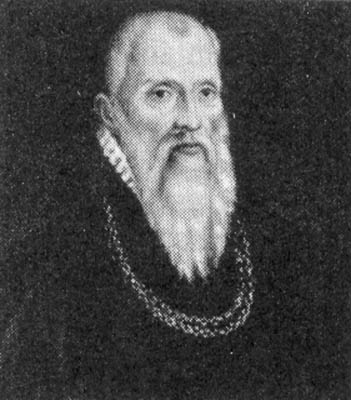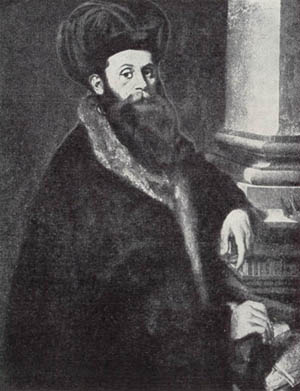Composer.
Zarlino relates that Willaert intended to study law at Paris but instead
became a pupil of
Jean Mouton and served at the court of Louis XII and Francis I. He may
have been in Rome in 1515, where according to Zarlino the papal choir of Leo
X mistook his motet Verbum bonumfor a work of
Josquin. (Apparently as soon as the singers learned that it was by the
still comparatively uncelebrated Adriano, they lost interest in it and
refused to excute it again.) From July 1515 he is listed among the retinue
of Cardinal Ippolito I d'Este, perhaps residing with the prelate in Hungary
from October 1517 until August 1519. He entered the employ of Duke Alfonso
upon Ippolito's death in 1520, remaining until 1527, when he was appointed
maestro di cappellaat St. Mark's in Venice; under him the chapel
there became one of the most prestigious in Europe.
 The
thirty-five years that Willaert gave to St. Mark's (1527 to 1562, the year
of his death) represent the best-known period of his life. The archives
yield documents not only concerning his appointment but also regarding
increases in salary, authorization to return to Flanders in 1542 and 1556,
eight wills drawn from 1549 to 1562, etc. There is information about the
hiring and discharging of singers, as in one source which states that a
singer was dismissed for refusing to go to Willaert for lessons in
counterpoint, "which is necessary in the choir and there is need for one to
know it." Other documents deal with the reorganization, in 1562, of the
choir into the cappella grandeand the cappella piccola,an
arrangement destined to continue until the regime of
Zarlino, although originally intended to last only during what proved to
be Willaert's final illness.
The
thirty-five years that Willaert gave to St. Mark's (1527 to 1562, the year
of his death) represent the best-known period of his life. The archives
yield documents not only concerning his appointment but also regarding
increases in salary, authorization to return to Flanders in 1542 and 1556,
eight wills drawn from 1549 to 1562, etc. There is information about the
hiring and discharging of singers, as in one source which states that a
singer was dismissed for refusing to go to Willaert for lessons in
counterpoint, "which is necessary in the choir and there is need for one to
know it." Other documents deal with the reorganization, in 1562, of the
choir into the cappella grandeand the cappella piccola,an
arrangement destined to continue until the regime of
Zarlino, although originally intended to last only during what proved to
be Willaert's final illness.
He was an important teacher, whose pupils included
Rore,
Vicentino,
Parabosco,
Andrea Gabrieli,Porta,
Buus,
Barré, and Zarlino, the last of whom lionized him in his treatises as
the perfecter of music. A participant in Venetian social and literary
circles, he figured in the work of Andrea Calmo, Pietro Aretino, and
Antonfrancesco Doni.
An interest in theoretical questions is indicated by
references to him in Spataro's correspondence as well as by a composition of
his from the time of Leo X, Quid non ebrietas,in which the tenor falls
through the circle of fifths, ending on a written seventh to be changed by
musica fictato an octave. His works include Masses, motets, hymns,
Psalms (some using the cori spezzatieffect then current in the
Veneto), madrigals, villanesche, chansons, and a lute intabulation of
Verdelot's madrigals. His best-known publication is the Musica nova,dedicated
to Alfonso II d'Este and published in 1559, though the contents probably
circulated long before that date as a collection named after the Venetian
singer Pulissena Pecorina.

Willaert's fame as a composer of sacred music rests largely on
his motets. Fewer than ten Masses have reached us. Five à 4appeared
in a Venetian print of 1536. The first, constructed on
Mouton's Quaeramus cum pastoribus,makes extensive use of the
beginning of the model, quoting it almost literally in its own initial
measures and skilfully varying it at later section-openings, and at some
other points. In the second Mass, Willaert freely expands or contracts
phrases of
Richafort's Christus resurgens.This Mass, as well as the fourth
one of the print, the Missa Gaude Barbara,survives in a MS that
includes also the model of the last-named work, an anonymous motet à 4.Of
the Masses à 5ascribed to Willaert, one bears his name in two MSS,
but Hesdin's in two others. This composition belongs to a group of
16th-century Masses that apply the
parody technique to
Josquin's setting à 6of the sequence, Benedicta es coelorum
Regina.Willaert himself wrote a motet setting of the sequence, but the
basing of the Mass on Josquin's setting rather than on his own does not
invalidate his claim to authorship: one source preserving this Mass--and
also a five-part Willaert Mass without a title--dates from 1530-31, whereas
Willaert's motet was not printed until 1539.
Willaert's three main contributions to sacred polyphony in
Italy-- the last two apparently made solely (aside from his activity as a
teacher) through his motets, etc.--were (i) the establishment of Franco-Netherlandish
technique as a part of the musical language of church music there; (2) the
development of choral antiphony; and (3) the cultivation of a "modern" style
emphasizing faultless declamation of the text.
![]()